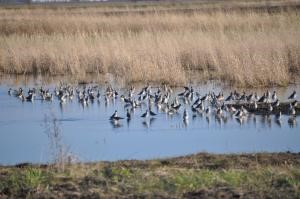Minnesota CREP
What is MN CREP?

Minnesota Conservation Reserve Enhancement Program (CREP) is a voluntary, federal-state funded natural resource conservation program that uses a science-based approach to target environmentally sensitive land.
Landowners will enter into a 15 year Conservation Reserve Program (CRP) contract, administered by the USDA-Farm Service Agency (FSA), and a Reinvest in Minnesota (RIM) perpetual conservation easement administered by the Minnesota Board of Soil and Water Resources (BWSR). Participants will receive financial incentives for both the CRP and RIM contracts for removing cropland from agricultural production and converting the land to native grasses, trees and other native vegetation.
Private ownership continues and the land is permanently restored and enhanced for conservation benefits. Minnesota is at a critical juncture in addressing the state’s water quality challenges. The state also is at risk of losing nearly 550,000 acres of critical grassland over the next 5 years from CRP contracts ending.
MN CREP is voluntary, locally driven and targets the most environmentally sensitive acres.
How does it work?

Minnesota CREP enrollment began in May 2017 and will continue to enroll land until funds run out or the 60,000 acre goal is reached. This program will focus on four main Conservation Practices, which have been identified through CRP:
1. Grass Filter Strips
2. Wetland Restoration – Non-Floodplain
3. Wetland Restoration – Floodplain
4. Wellhead Protection Area
Minnesota CREP will convert environmentally sensitive cropland to native vegetation in order to improve water quality, reduce soil erosion, increase flood water storage, and provide for fish and wildlife habitat. Establishment of certain practices in native vegetation will greatly reduce runoff of sediments, nutrients, pesticides, and pathogens from agricultural sources. CREP will also increase the water storage capacity of the watersheds through wetland restoration. Restoring native vegetation will increase wildlife habitat, which will benefit flora and fauna including threatened and endangered species. Other agricultural impacts mitigated by a CREP include fragmentation of riparian corridors, grasslands, and forest-lands.
Why Enroll Now?

There are many reasons to consider MN CREP now, based on the long-term goals of the landowner. Some of these include:
Fair Compensation – MN CREP combines Conservation Reserve Program (CRP) contract payments and Reinvest in Minnesota (RIM) easement payments.
Rights Retained – Landowners maintain ownership, including the right to control access to the land covered by the MN CREP CRP contract/RIM easement.
Returns on Marginal Cropland – MN CREP prioritizes and targets marginal cropland that is often associated with buffer areas and drained or altered wetlands. These lands often produce less than average crop yields, and are less profitable even when crop prices are high.
Impact on Water Quality and Habitat – MN CREP focuses on both water quality and wildlife habitat. Enrolled land will deliver multiple benefits to ground and surface water, as well as provide habitat for pollinators and wildlife.
Option for Re-Enrolled CRP – Lands that are currently enrolled in CRP and eligible for re-enrollment during a MN CREP sign-up period may be eligible. This can result in seamless coverage of CRP annual payments and may allow for the existing vegetation to stay in place.

Volatile Land Prices – According to the University of Minnesota and other resources, farm land prices have declined over the past two years and appear to still be on the declining trend.
Quality Native Restoration – Restoration of the enrolled land will follow state and federal standards, and focus on native plant species. One hundred percent of these restoration costs will be covered by the CRP and RIM programs, leaving no out-of-pocket expenses to the landowner.
